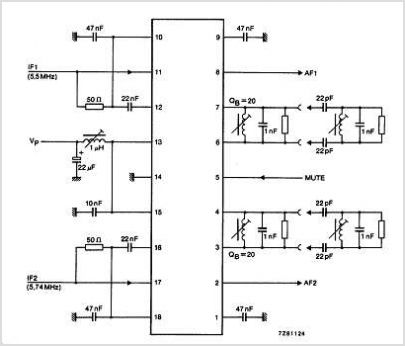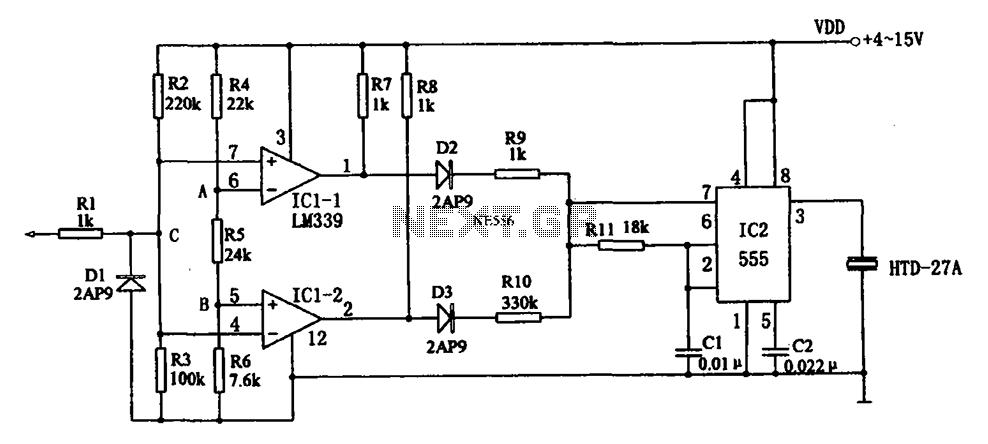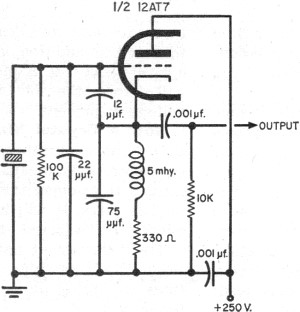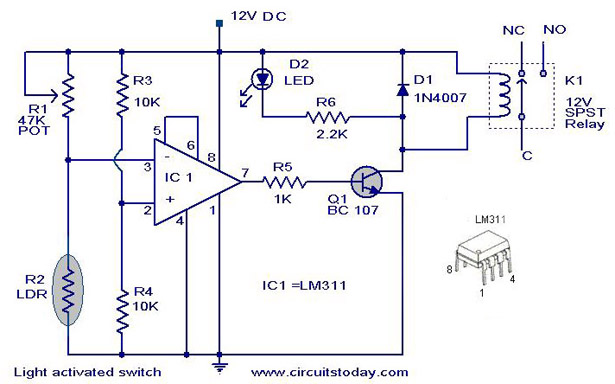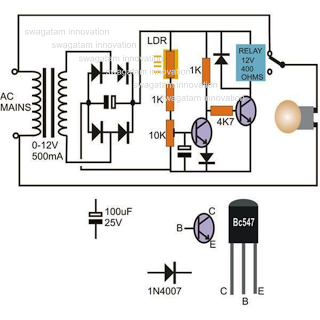
555 ics hysteresis for dark activated

This circuit is designed to activate a relay in response to low light conditions, meaning the relay will engage when the light intensity drops below a specified threshold. In the absence of hysteresis, the relay will turn on and off as the brightness fluctuates around a single darkness threshold. However, implementing hysteresis allows for different activation and deactivation brightness levels, effectively addressing the issue of relay oscillation caused by minor variations in light intensity. The circuit utilizes a 555 timer IC to leverage its built-in hysteresis, which is defined by 1/3 and 2/3 of the supply voltage. A Light Dependent Resistor (LDR) or Cadmium Sulfide (CDS) cell is employed with a resistance range of 2 to 8 kΩ at the desired light level. In darkness, the resistance of the LDR increases, triggering the relay once the voltage at pin 2 reaches 2/3 of the supply voltage (8V). After activation, additional light is required to lower the LDR's resistance sufficiently for the voltage at pin 2 to drop below 1/3 of the supply voltage (4V), thereby deactivating the relay.
This circuit operates on the principle of light intensity sensing using an LDR in conjunction with a 555 timer configured in a comparator mode. The 555 timer's thresholds are critical for establishing the points at which the relay will activate and deactivate. When the ambient light level decreases, the LDR's resistance increases, resulting in a higher voltage at the input pin of the 555 timer. Once this voltage exceeds 2/3 of the supply voltage, the output of the 555 timer switches from a low to a high state, activating the relay.
The hysteresis feature is vital for preventing rapid on-off cycling of the relay, which can occur if the light levels fluctuate around the threshold. With hysteresis, the activation point (2/3 of the supply voltage) is distinct from the deactivation point (1/3 of the supply voltage). This ensures that the relay remains engaged until a significant increase in light intensity occurs, thereby providing a stable operation in varying light conditions.
The choice of LDR or CDS cell is essential, as these components exhibit varying resistance based on the light levels they are exposed to. The selected resistance range of 2 to 8 kΩ is optimal for achieving the desired sensitivity and response time. Additionally, the circuit can be powered by a supply voltage of 12V, which is common in many applications, ensuring compatibility with standard relay modules.
In summary, this circuit effectively utilizes the properties of a 555 timer IC alongside an LDR to create a reliable light-activated relay system with hysteresis, suitable for applications requiring automatic control based on ambient light conditions.This is a circuit that can be used for dark activated means the relay will be activated when thelight intensity fall below a certain threshold. Without hysteresis, the relay will be activated and deactivated if the sensed brightness fall under or rise above a single point of darkness level.
With hysteresis, the darkness level for activating and de activating the relay will be different, and this solve the relay oscillation problem when the light intensity is swinging up and down around a single point of no hysteresis activation level. Here`s the figure of the circuit; We can employ the hysteresis of a 555 IC to improve the sensingof a drop in light, since the internal 555 circuit has 1/3 and 2/3supply voltage thresholds.
We have to use a LDR or CDS cell with out 2 to 8 k resistance at desired light level. At the dark, the resistance of the LDR will rise and activate the relay if the voltage at pin 2 reach 2/3 of supply voltage (8V). After the relay is activated, more light is needed to make the LDR decrease its resistance until the voltage at pin 2 falls below 1/3supply voltage (4V).
🔗 External reference
This circuit operates on the principle of light intensity sensing using an LDR in conjunction with a 555 timer configured in a comparator mode. The 555 timer's thresholds are critical for establishing the points at which the relay will activate and deactivate. When the ambient light level decreases, the LDR's resistance increases, resulting in a higher voltage at the input pin of the 555 timer. Once this voltage exceeds 2/3 of the supply voltage, the output of the 555 timer switches from a low to a high state, activating the relay.
The hysteresis feature is vital for preventing rapid on-off cycling of the relay, which can occur if the light levels fluctuate around the threshold. With hysteresis, the activation point (2/3 of the supply voltage) is distinct from the deactivation point (1/3 of the supply voltage). This ensures that the relay remains engaged until a significant increase in light intensity occurs, thereby providing a stable operation in varying light conditions.
The choice of LDR or CDS cell is essential, as these components exhibit varying resistance based on the light levels they are exposed to. The selected resistance range of 2 to 8 kΩ is optimal for achieving the desired sensitivity and response time. Additionally, the circuit can be powered by a supply voltage of 12V, which is common in many applications, ensuring compatibility with standard relay modules.
In summary, this circuit effectively utilizes the properties of a 555 timer IC alongside an LDR to create a reliable light-activated relay system with hysteresis, suitable for applications requiring automatic control based on ambient light conditions.This is a circuit that can be used for dark activated means the relay will be activated when thelight intensity fall below a certain threshold. Without hysteresis, the relay will be activated and deactivated if the sensed brightness fall under or rise above a single point of darkness level.
With hysteresis, the darkness level for activating and de activating the relay will be different, and this solve the relay oscillation problem when the light intensity is swinging up and down around a single point of no hysteresis activation level. Here`s the figure of the circuit; We can employ the hysteresis of a 555 IC to improve the sensingof a drop in light, since the internal 555 circuit has 1/3 and 2/3supply voltage thresholds.
We have to use a LDR or CDS cell with out 2 to 8 k resistance at desired light level. At the dark, the resistance of the LDR will rise and activate the relay if the voltage at pin 2 reach 2/3 of supply voltage (8V). After the relay is activated, more light is needed to make the LDR decrease its resistance until the voltage at pin 2 falls below 1/3supply voltage (4V).
🔗 External reference
